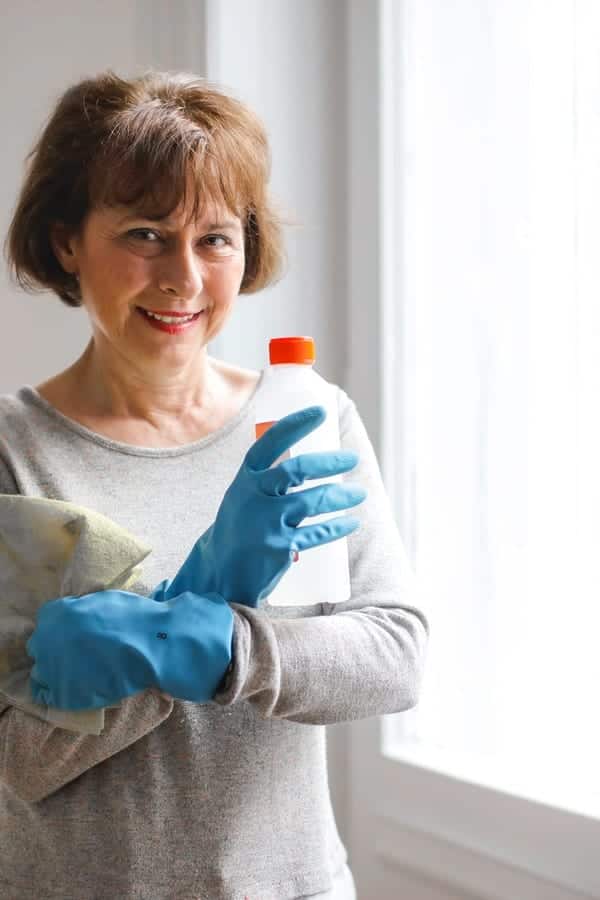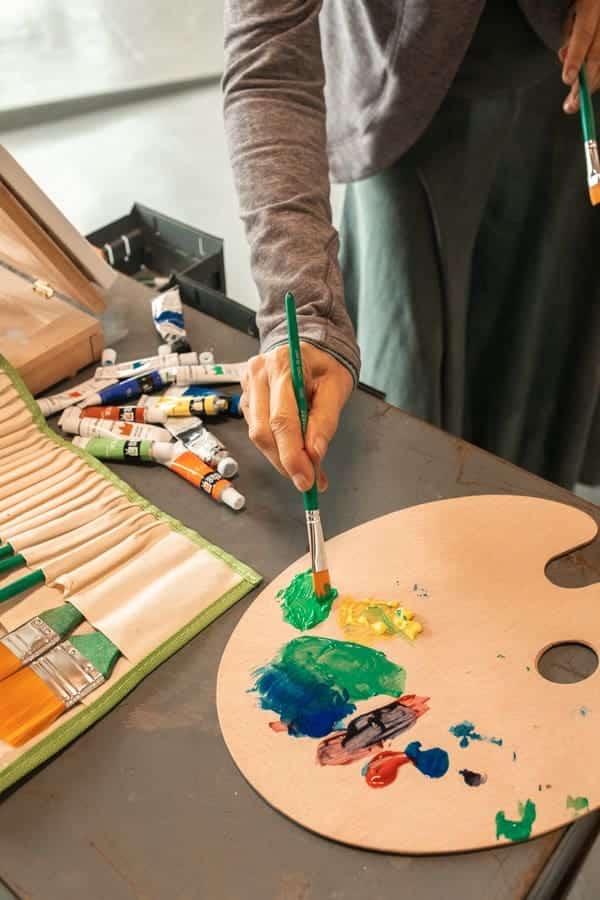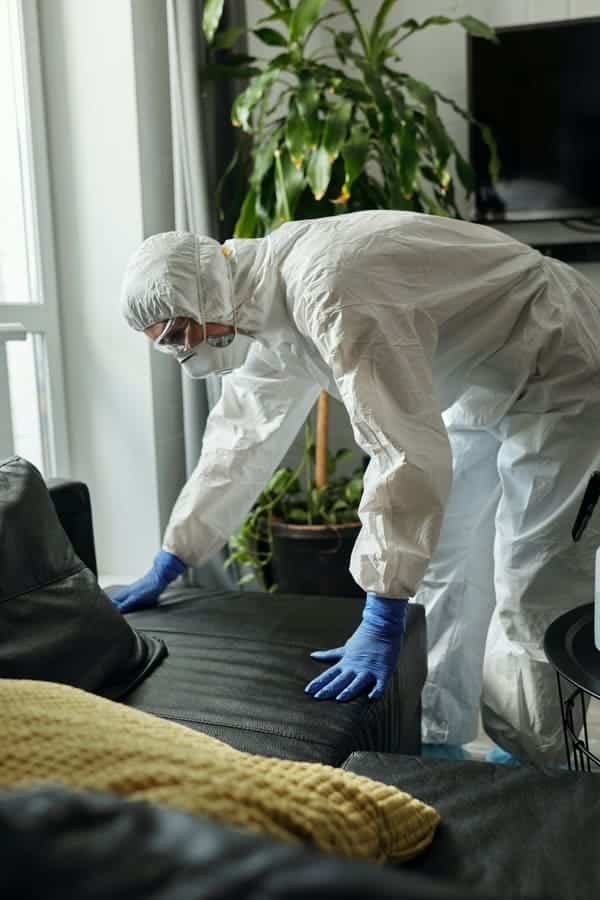Painting can be a messy task, no matter how many precautions you take; and acrylic paint is particularly tough to remove from unwanted areas. Luckily any accidents are rectifiable. This article shows you how to remove acrylic paint from wood.
There are a few options on how you can remove acrylic paint from wood.
There may be affiliate links in this article. You can read more about this in my disclosure.
Soap & Water
Acrylic paint is water-based, meaning water (namely hot water) will help it budge. For this method you will need hot soapy water and cleaning rags/sponges.
Please note: this method is only effective when the paint is still wet, so you’ll need to act fast.
Method:
- Create a thickish mixture of dish soap and hot water. Stir to lather up.
- Dampen your cloth/sponge with the hot soapy water.
- Wipe the acrylic paint off the wood.
- Use more soapy water to wash the paint spill away (which will stain if left ignored).
- Clean off any residue with the wet cloth (may also stain).
- Wipe the wooden surface with a dry cloth to eliminate excess water and paint residue.
Vegetable Oil
Using vegetable oil will work if your acrylic paint has dried and set. For this method you will need paper towels, olive oil, clean rag, and a putty knife.
Method:
- Put some olive oil directly on the acrylic paint. Then, rub the oil gently using a paper towel.
- Make sure that the olive oil covers the entire paint spill. Be generous with your oil.
- Leave the oil to soften the paint for about 15 minutes. Avoid touching the wooden surface while the paint softens.
- Scrape the paint off using your putty knife (or a paint scraper, if you have one).
- Apply gentle pressure so you only remove the paint stain and do not scratch the varnish.
- Use a damp rag to wipe off all the paint and the oil traces. Repeat the process until all the paint has been removed.
Rubbing Alcohol
Naturally alcohol is a potent substance that can lift many other liquids.
For this method you will need neat, clear alcohol (such as vodka), rubbing alcohol, or isopropyl alcohol, clean cloth(s), a putty knife/paint scraper, elbow grease, and wire wool or a silver scouring pad.
This is your best option to get acrylic paint from bare or unvarnished wood. You can also use it on a varnished surface, but it may dull the shine, and require another paint-job.
[amazon box=”B07NFSFBXQ” template=”vertical”]Method:
- Use your putty knife or paint scraper to scrape off the dried paint from your wood surface. The goal here is to remove as many paint layers as possible to make the rubbing easier. Be careful not to damage the wood.
- Pour some rubbing alcohol on a cloth with some elbow grease. Be generous with the amount.
- Rub the alcohol over the remaining paint spots from scraping, applying pressure (but again, being mindful not to cause damage to the woodwork). Repeat until you’re happy with the result.
- Use a soapy cloth to wipe away the paint and rubbing alcohol residue. Then wipe the wood dry using a dry, clean cloth.
Precautions When Using Rubbing Alcohol to Clean Acrylic Paint
- Alcohol in all its forms is highly flammable, so never use a container with an open flame or excessively hot surface on it, as this could cause the fire to spread. This includes avoiding smoking until the job is done.
- If doable, make sure the location of this task is outdoors or well-ventilated.
- Keep rubbing alcohol away from children.
- Always keep rubbing alcohol in its original packaging. Never convert to another bottle that could be confused as a beverage.

Denatured Alcohol
Depending on the quantity or toughness of your paint stain, you may need something a little more heavy-duty than rubbing alcohol, and denatured alcohol may just do the trick.
For this method you’ll need a few more tools than the others: denatured alcohol, paint scraper/pallet knife, a clean rag, paintbrush or paint roller, gloves, respirator or a mask, liquid Soap and water, and a cotton ball/wool.
Please note: this option is best suited for removing dried paint stains on unfinished or unvarnished wood.
[amazon box=”B0754NR5B8″ template=”vertical”]Method:
- Wet your clean cloth or paintbrush in denatured alcohol.
- Apply a generous coat of alcohol over the dried paint to be removed. Let the alcohol dissolve the acrylic resin for about two to five minutes.
- Use a putty knife or paint scraper to scrape off the softened paint. Be gentle as either can damage the wood if applied too harshly.
- Repeat the application and scraping process as necessary until you can remove all the acrylic paint from the wood.
- Dampen a rag in clean water to remove all traces of the alcohol.
Heat Gun
This option is ideal if your spillage is on a larger wooden space, such as a porch.
For this method you will need Heat gun, goggles, heat-proof gloves, mask or respirator, a putty knife or paint scraper, and a clean rag.
[amazon box=”B078S5QMFG” template=”vertical”]Method:
- Put on your mask or respirator and your gloves. This is important. Gloves will need to be made of leather, or a similar fabric that will guarantee protection to your hands. Ensure the room is well-ventilated if you can’t work in an open-air space.
- Set the heat gun to the maximum setting and hold it about 4 inches away from the paint. Next, move the heat gun in short circular motions.
- Scrape off the paint once you see it form bubbles on the surface. Hold the putty knife/scraper in another hand and scrape the paint following the direction of the wood grain. Scrape gently so you don’t damage the wood.
- Once the wood has cooled down, wipe it with a damp rag using soap and water to remove any paint residue.
- Wipe the wood with a damp rag and allow to air dry.

Precautions When Using a Heat Gun
A heat gun is dangerous if used without care, so the following needs to be adhered to:
- Wear protective clothing, like gloves that protect your skin from burns.
- Point the heat gun away from any living creatures who may come into the near proximity.
- Keep an extinguisher handy.
- Do not let children or anyone under the influence of alcohol or drugs use the heat gun.
- Heat guns are not toys and should be treated with the utmost respect.
Solvent
Paint solvents are naturally one of the most reliable sources of paint removal. You can choose from methylene chloride, ammonia, or lacquer thinner.
Solvent can be deadly if misused, so ALWAYS wear protective gear when handling.
For this method you will need paint solvent, goggles, chemical-resistant gloves, respirator or mask, clean cloths, plastic paint scraper, mineral spirits, and a paintbrush.
Because of the toxicity of this product, it’s best to contact a professional for help. It is wise to perform this method in an outdoor/well-ventilated space, if possible.
[amazon box=”B007RO1ULA” template=”vertical”]Method:
- Wear your protective gear – goggles, gloves, respirator and a long-sleeved outfit. You want to avoid any chances of the chemical coming into contact with your skin. Also, ensure you work in a well-ventilated space to protect your lungs.
- Using your paintbrush, apply a thin coat of the solvent to the paint. Let it sit for as long as the manufacturer recommends.
- Scrape off the paint once you see bubbles. Use a plastic paint scraper or putty knife to scrape along the direction of the wood. A metal putty knife might gouge the wood, so plastic is the best material.
- Soak a fresh cloth in mineral spirits, then use it to wipe the wood surface. This will neutralise the wood and remove any lingering paint and solvent residue.
Conclusion

So, while acrylic paint can be quite stubborn to remove, there are multiple solutions as to how to remove it safely and effectively from wood.
However, as many of these options involve either harsh chemicals or potentially dangerous instruments, it is important to put safety first and adhere to all precautions, and if in doubt, seek advice from a professional woodworker.
Always follow the instructions on any paint-removing products and make sure you have the correct PPE before starting the task.



